Ahoy planeswalkers! It’s that time again. We have had time to digest the fully-revealed set for Dominaria, so now it’s time to take a closer look at some of the cards that have caught my eye. And so, without further ado, here are few cards whose storytelling, alone or in concert with the set’s larger themes, has captivated me.
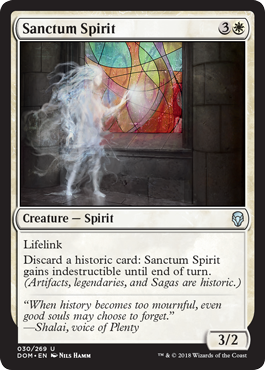
What interests me here is the stained glass. Most of the stained glass we see in New Benalia is pictorial or somewhat symmetrical, built around a series of sharp, defined shapes; this window lacks such patterns, more resembling the experiments with shape and color of twentieth-century abstract art. With the flavor text and the white force from the spirit’s fingers, what I read into this is that the stained glass once did depict something concrete, and has been overwritten by this spirit choosing forgetfulness. That’s a really interesting story alongside the emphasis on history and memory in this set.
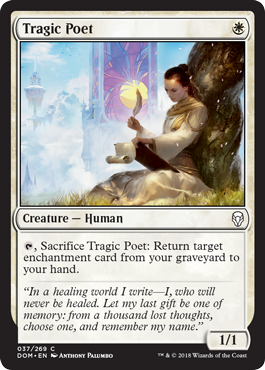
“In a healing world I write—I, who will never be healed” puts me in mind of Livejournal angst. Not necessarily in a bad way—no one says the Tragic Poet also has to be a good poet. But it is the second half of this flavor text hits home for me. As a theatre historian, my work centers on a handful of people who have not been remembered. To a large extent, my Ph.D. dissertation is making the case for their memory. The importance of history and memory imbues this set as a strong through line. This unnamed Tragic Poet’s flavor text does a wonderful job of bringing a small, personal touch to the stakes of memory amidst this set’s sea of legends.
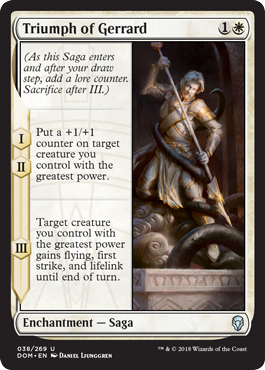
Sagas are among my favorite cards in the set. The range of different artistic styles and media evoked by the art contribute brilliantly to the impact of each individual piece and the set as a whole, from the renaissance-esque marble statue of the heroic Gerrard to the woven tapestry of Time of Ice to the stained glass of History of Benalia. Mike Linnemann went deep on the sagas in a way that I don’t have the artistic background to match, and if you haven’t checked out his work on these exquisite pieces, you really should.
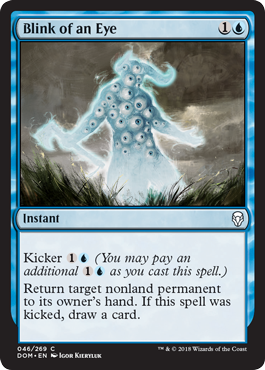
I have never been more curious to read a card’s art description. Blink of an Eye is such a quintessential “bounce spell” card name, conjuring both the subtlety and the odd dread of something like Just The Wind. I love the frustrated expectation that lies between the title and the surprisingly (and horrifically) literal art, and I’m terribly curious how we got here.
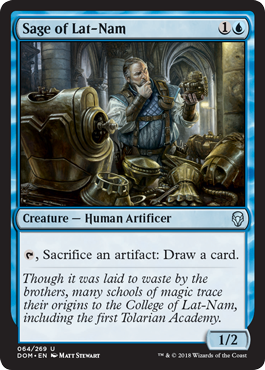
I really like the way the rules text informs the art here. When I see this picture, my first thought is that the sage is trying to put the machine back together. The rules text, however, reveals that it’s the opposite. The sage is pulling an old automaton apart in order to understand it, destroying it to gain knowledge. Destroy an artifact, draw a card. Is the knowledge worth the destruction?
It also ties into to a larger thread that runs all through Dominaria’s history: the destructive power of research and science. Where, say, Kaladeshi science is driven by a spirit of creation, destruction looms large in the research of Urza and the multiple cataclysms he saw the plane through (and brought about). The destructive nature of research surges to the fore on several cards in the set, such as Arcane Flight. The power in the work of Dominaria’s sages is undeniable, but the cost and the danger of that power loom large.
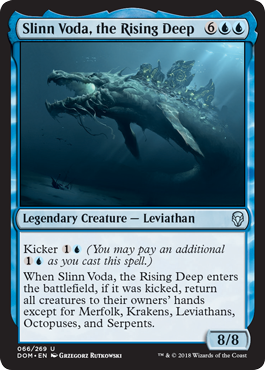
Maybe Nicol Bolas should have a chat with Slinn Voda. It was a god once, too.
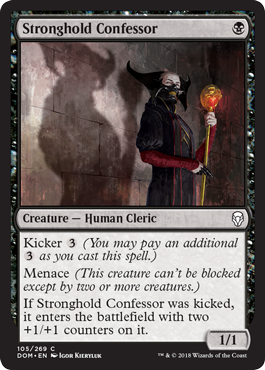
I’m a sucker for shadow hijinks. The way this confessor’s armor makes her shadow look like Demonlord Belzenlok simultaneously speaks to Belzenlok’s vanity—he is shaping his minions in his own image, much the way he is shaping Dominaria’s history in his own image—and speaks to the confessor’s total devotion to serving her patriarch and the ideals that he represents in her mind.
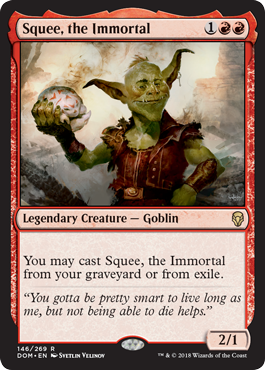
The decision to drop the Hamlet reference in Squee’s posing is inspired and surprisingly layered. At first glance, Squee recalls Hamlet with Yorick’s skull, one of the most famous and visually evocative scenes in the play; with the punchline of the irreverent, smiling Squee standing in place of the serious, contemplative Hamlet.
If you go deeper, though, you might remember that the character who pulls Yorick’s skull out of the ground is not the Danish prince but the clownish gravedigger. Squee had a long run as a comic character aboard the Weatherlight (boy, did he love messing with Tahngarth), and using a classic comic character as his reference is brilliant. That character being a Gravedigger, meanwhile, echoes off of Magic’s famed graveyard recursion engine of the same name, a card that bears some resemblance to Squee in his ability to recur himself infinitely.
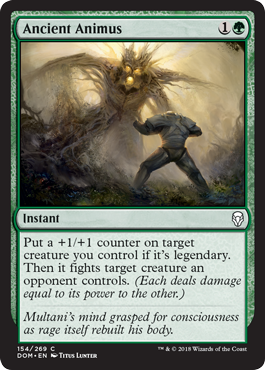
Well, this is interesting.
Jay Annelli has pointed out we seem to be heading for Karn versus Molimo. His theory is that Karn may be searching for the Golgothian Sylex, the artifact of apocalyptic power that Urza used to end the Brothers’ War (as depicted on Urza’s Ruinous Blast), intent on using it to destroy New Phyrexia. It feels noteworthy that Karn is not taking the oath this time around, although that seems like something that Karn would do. Karn being focused on New Phyrexia and finding a way to stop the praetors would be a satisfying explanation for this.
This would be an interesting avenue to go down because it would also point towards Karn becoming more like most of the other elder planeswalkers we know: losing sight of the individual lives on a plane amidst cosmic battles. (Perhaps this is the influence of Urza, whose powerstones became part of Karn at the end of the Phyrexian invasion.) Given that Urza has apparently hidden goodies throughout the plane, it certainly seems likely that Annelli is right and Karn is after some artifact that might help stop New Phyrexia. I will be eager to see how this plays out in Magic Story.
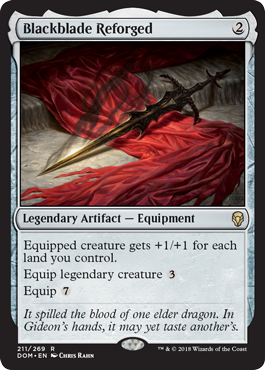
Hey, what happens when you give a well-meaning knight a powerful, creepy-looking relic for a weapon? Because the stortelling tropes behind this image of the Blackblade scream “great power at great cost.” What that cost might be, however, is unclear—typically it’s the death of someone close to the wielder, but Gideon himself seems to be the Gatewatch member most marked for death.
One possibility worth watching? If we return to Theros, keep an eye out for whether Gideon’s old mentor Hixus, Prison Warden is still around. The Blackblade bringing about his death (especially if Gideon takes it up against the gods) would satisfy that story space and provide more room for Gideon trying to figure himself out.
Beck is a financial aid counselor and theatre history Ph.D. student who lives in the greater Boston area. He believes in playing standard like a Johnny, drafting like a Spike, and only playing modern decks that involve the number eight.

